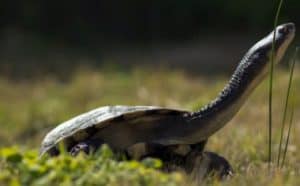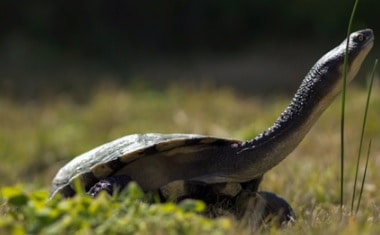 Long necked turtle or commonly known as snake necked turtle is a breed of a turtle which is easy to be found at the eastern side of the world, such as many parts of Australia and places which are filled with freshwater.
Long necked turtle or commonly known as snake necked turtle is a breed of a turtle which is easy to be found at the eastern side of the world, such as many parts of Australia and places which are filled with freshwater.
Even though not many have known or even familiar with the name of long necked turtle or snake necked turtle. This type of turtle can be found in almost every part of South Australia. What makes this breed of turtle unique is that the neck which is not like any other breed of turtle, it has a long neck, almost like a snake.
Other articles you may also read :
Classification
Now that we have seen some of the unique facts of long necked turtles, below is the classification.
- Species : longicollis
- Genus : Chelodina
- Family : Chelidae
- Subclass : Testudinata
- Class : Reptilia
- Subphylum : Vertebrata
- Phylum : Chordata
- Kingdom : Animalia
Other articles you may also read :
To know more about the long necked turtle, we have provided you with some cool and unique long necked turtle facts.
1. Habitat
Long necked turtles are distributed across the south east of Australia, Queensland, New South Wales, and Victoria. They also can be found in fresh waters environments such as dams, billabongs, swamps and rivers. Long necked turtles are slow moving. Due to the majority of these long necked turtle breeds are to be found in many parts of Australia, they are often called as easter long neck turtles.
Other articles you may also read :
2. Diet
Unlike other breeds of turtles, these long necked turtles are strictly carnivorous. It means that they only eat meat. The died of long necked turtles are often consists of insects, worms, tadpoles, frogs, yabbies, small fishes and crustaceans. They have powerful claws on its front feet which are used to broken up large preys.
Other articles you may also read :
- Balinese Wedding Traditions
- Marriage Culture in Indonesia
- Kecak Dance In Bali
- Ngaben in Bali
- Barong Dance in Bali
- Tana Toraja Death Rituals
3. Breeds
The female and male species of long necked turtles can be differentiated by sexual dimorphism. Female breed of long necked turtles is generally to grow larger than the male breed of long necked turtle. Females can grow up to 26 cm while compared to that of the males can grow up to 21cm. The male sex scutes are predominate in ‘V’ shaped, where as the females’ are predominate in ‘U’ shaped. The male breed of long necked turtle also generally have a longer tail.
Other articles you may also read :
When the female and male long necked turtles breeds, the female turtle can lay around four to twenty four eggs by early Summer. Usually, the female breed of long necked turtle tends to lay her eggs in the bank of her aquatic habitat, above the waterline and then bury the eggs in the soil. Female breed of long necked turtles may have one to three clutches a year.
Other articles you may also read :
- Balinese Dance
- Traditional Dances of Indonesia
- Haunted Places in Indonesia
- Bali Facts
- Rafting in Bali
- Cultures in Bali
4. Eggs
The eggs of long necked turtles are long, pointy, and hard shelled. The incubation period of long necked turtles’ eggs is around three to five months period. They usually hatched right after the rain has softened the soil above the nesting chamber and they will scuttle straight to the water. The babies of long necked turtles have their colorings different from the adults that are by having a red or orange plastron.
Other articles you may also read :
- Piracy in Indonesia
- Traditional Balinese Dishes
- Traditional Sports in Indonesia
- Culture of Yogyakarta
- Javanese Traditions
- Indonesia Business Cultures
5. Migration
Even though it is less to be seen or sometimes the migration of long necked turtles can not be seen happens, but they do migrate. Usually at the intense summer where the sign of droughts are visible, or even at the times of fresh water crisis. The long necked Turtle will migrate to new places in looking for new bodies of water.
Other articles you may also read :
- Oldest Temple in Indonesia
- Largest Temple in Indonesia
- History of Tanah Lot
- Traditional Balinese Dishes
- Fruits of Indonesia
- Eating Habits in Indonesia
6. Surviving drought
Long necked turtles have some ways of surviving drought. At the sign or indication of intense drought conditions, these long necked turtles will bury themselves in any left over mud or soil in what was the deepest part of the waterhole. Therefore they can survive the drought and still have enough water to continue their life without any water crisis.
Other articles you may also read :
7. Appearance and Color
The appearance divided by two, shells and neck. Here the information.
Shells
The long necked turtle shells are generally black in color though some may have the brown color. The shell is broad and flattened with a deep medial groove. The scutes of long necked turtle or snake necked turtle are often edged in black, especially in those long necked turtle who is with a lighter background color. The plastron on the long necked turtle shell is also very broad and is cream to yellow in color with sutures edged in black, while on the babies of long necked turtles which have just been hatched, the plastron is often in red color.
Other articles you may also read :
- Traditional Sports in Indonesia
- Highest Mountain in Indonesia
- Customs of Indonesia
- Traditional Dances of Indonesia
Neck
The neck of every long necked turtle is very long and narrow, typical of every animal from the subgenus Chelodina. The neck it self can reach the length of approximately of sixty percent of the entire long necked turtles’ length. The long necked turtle has numerous small pointed tubercles and is from grey to black in color on the top and cream in color on the below part.
Other articles you may also read :
- Best Nightlife in Indonesia
- Famous Indonesian Street Food
- Street Food in Bali
- Coffee in Indonesia
- Fruits of Indonesia
- Hiking in Indonesia
Other Facts (8-18)
Those eight are some unique facts of long necked turtles which you may not even aware of. Apart from above listed facts of long necked turtles or the Eastern snake necked turtles, below are some unique facts.
- Long necked turtles are also known by another name and called Stinker. This is mainly because they can eject pungent liquid gland secretions from their armpits and groin when disturbed or being preyed by larger animals.
- Known for the long neck which gives name another name that is snake necked turtle.
- Their long neck is protected by the shell in both sideways. (see also: Endangered Animals in Indonesia )
- Their long neck is used to strike the prey such as frogs, fish, tadpoles and freshwater crayfish.
- The long necked turtles have very powerful jaws and strong claws which are used to tear apart larger prey.
- The eggs of long necked turtles are often eaten by water-rats or large lizards and the babies after being hatched from the eggs are often eaten by large fish and birds. (see also: Native Animals in Indonesia)
- They usually breed in the summer. (see also: Javan Leopard Facts)
- Mostly found in Queensland, New South Wales, Victoria and parts of South Australia.
- Many of adults long necked turtles are being killed by cars while moving overland. (see also: Bornean Bay Cat Facts)
- The long necked turtles or snake necked turtles often feed on aquatic invertebrates, tadpoles, and small fishes.
- They spent most of their time in the fresh waters and will move to overland while migrating.
Other articles you may also read :
- Religious Beliefs in Indonesia
- Natural Resources of Indonesia
- Traditions in Bali
- Luwak Coffee
- What to Wear in Indonesia
- Indonesian Night Markets
Those are some interesting facts of long necked turtles. Even though it is mostly found in Australia continent, the long necked turtle is quite famous. The name turtle is also bringing some confusion as to turtles which live in the water or near water are supposed to be called as the tortoise, however due to the Australians and Australia has no habitat of tortoise, the long necked turtles are then being classified as the turtle instead of the tortoise.
See also:
